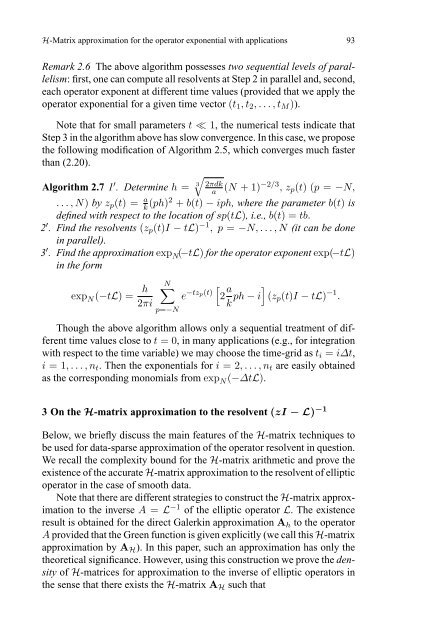H-Matrix approximation for the operator exponential with applications
H-Matrix approximation for the operator exponential with applications
H-Matrix approximation for the operator exponential with applications
You also want an ePaper? Increase the reach of your titles
YUMPU automatically turns print PDFs into web optimized ePapers that Google loves.
H-<strong>Matrix</strong> <strong>approximation</strong> <strong>for</strong> <strong>the</strong> <strong>operator</strong> <strong>exponential</strong> <strong>with</strong> <strong>applications</strong> 93<br />
Remark 2.6 The above algorithm possesses two sequential levels of parallelism:<br />
first, one can compute all resolvents at Step 2 in parallel and, second,<br />
each <strong>operator</strong> exponent at different time values (provided that we apply <strong>the</strong><br />
<strong>operator</strong> <strong>exponential</strong> <strong>for</strong> a given time vector (t 1 ,t 2 ,...,t M )).<br />
Note that <strong>for</strong> small parameters t ≪ 1, <strong>the</strong> numerical tests indicate that<br />
Step 3 in <strong>the</strong> algorithm above has slow convergence. In this case, we propose<br />
<strong>the</strong> following modification of Algorithm 2.5, which converges much faster<br />
than (2.20).<br />
√<br />
Algorithm 2.7 1 ′ . Determine h = 3 2πdk<br />
a<br />
(N +1)−2/3 ,z p (t) (p = −N,<br />
...,N) by z p (t) = a k (ph)2 + b(t) − iph, where <strong>the</strong> parameter b(t) is<br />
defined <strong>with</strong> respect to <strong>the</strong> location of sp(tL), i.e., b(t) =tb.<br />
2 ′ . Find <strong>the</strong> resolvents (z p (t)I − tL) −1 ,p= −N,...,N (it can be done<br />
in parallel).<br />
3 ′ . Find <strong>the</strong> <strong>approximation</strong> exp N (−tL) <strong>for</strong> <strong>the</strong> <strong>operator</strong> exponent exp(−tL)<br />
in <strong>the</strong> <strong>for</strong>m<br />
exp N (−tL) =<br />
h<br />
2πi<br />
N∑<br />
p=−N<br />
e −tzp(t) [ 2 a k ph − i ]<br />
(z p (t)I − tL) −1 .<br />
Though <strong>the</strong> above algorithm allows only a sequential treatment of different<br />
time values close to t =0, in many <strong>applications</strong> (e.g., <strong>for</strong> integration<br />
<strong>with</strong> respect to <strong>the</strong> time variable) we may choose <strong>the</strong> time-grid as t i = i∆t,<br />
i =1,...,n t . Then <strong>the</strong> <strong>exponential</strong>s <strong>for</strong> i =2,...,n t are easily obtained<br />
as <strong>the</strong> corresponding monomials from exp N (−∆tL).<br />
3 On <strong>the</strong> H-matrix <strong>approximation</strong> to <strong>the</strong> resolvent (zI −L) −1<br />
Below, we briefly discuss <strong>the</strong> main features of <strong>the</strong> H-matrix techniques to<br />
be used <strong>for</strong> data-sparse <strong>approximation</strong> of <strong>the</strong> <strong>operator</strong> resolvent in question.<br />
We recall <strong>the</strong> complexity bound <strong>for</strong> <strong>the</strong> H-matrix arithmetic and prove <strong>the</strong><br />
existence of <strong>the</strong> accurate H-matrix <strong>approximation</strong> to <strong>the</strong> resolvent of elliptic<br />
<strong>operator</strong> in <strong>the</strong> case of smooth data.<br />
Note that <strong>the</strong>re are different strategies to construct <strong>the</strong> H-matrix <strong>approximation</strong><br />
to <strong>the</strong> inverse A = L −1 of <strong>the</strong> elliptic <strong>operator</strong> L. The existence<br />
result is obtained <strong>for</strong> <strong>the</strong> direct Galerkin <strong>approximation</strong> A h to <strong>the</strong> <strong>operator</strong><br />
A provided that <strong>the</strong> Green function is given explicitly (we call this H-matrix<br />
<strong>approximation</strong> by A H ). In this paper, such an <strong>approximation</strong> has only <strong>the</strong><br />
<strong>the</strong>oretical significance. However, using this construction we prove <strong>the</strong> density<br />
of H-matrices <strong>for</strong> <strong>approximation</strong> to <strong>the</strong> inverse of elliptic <strong>operator</strong>s in<br />
<strong>the</strong> sense that <strong>the</strong>re exists <strong>the</strong> H-matrix A H suchthat
















